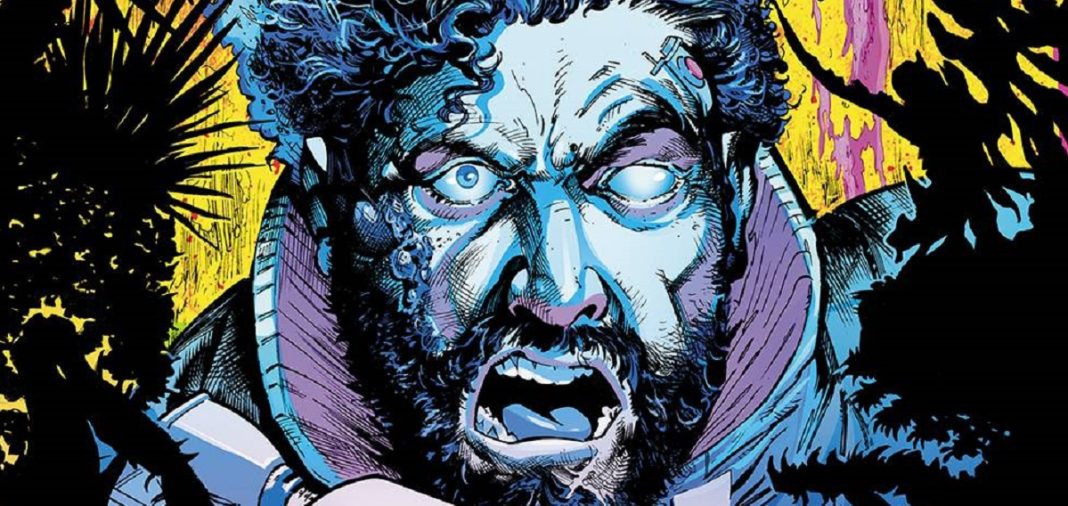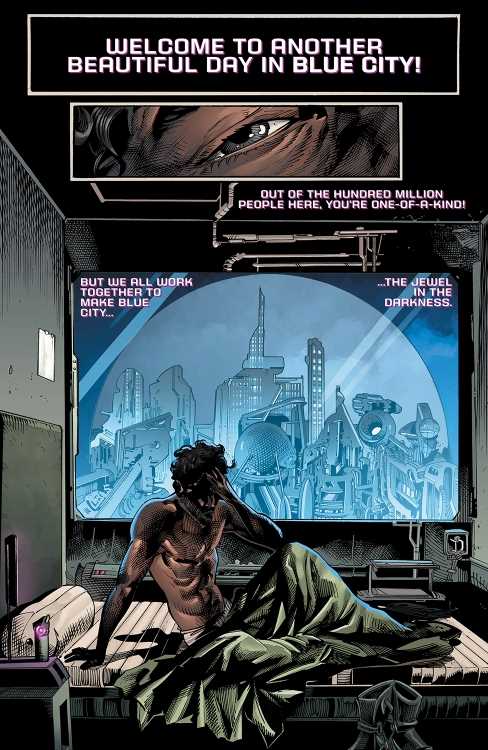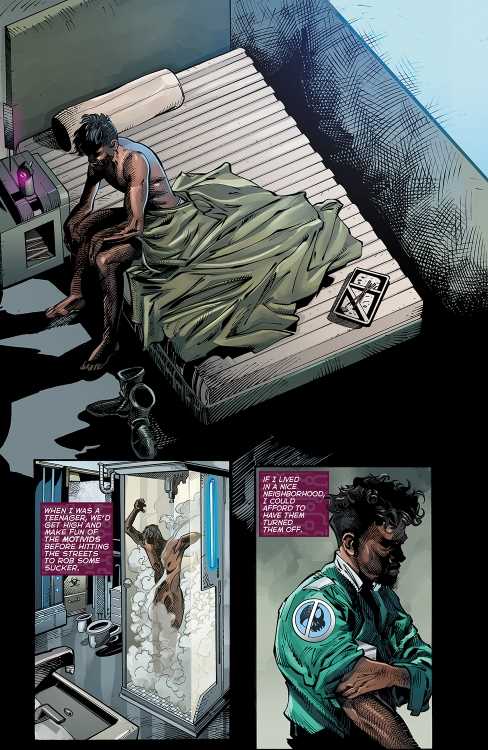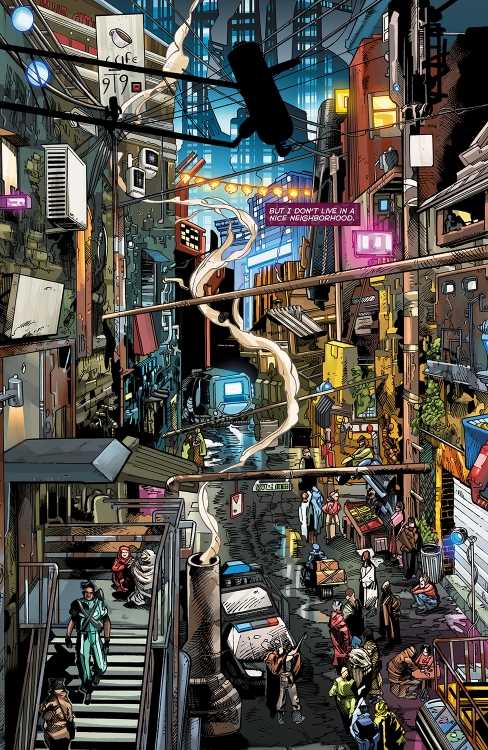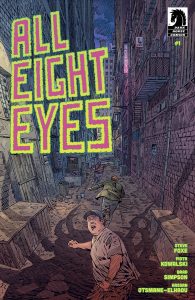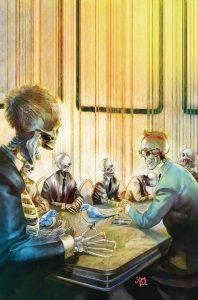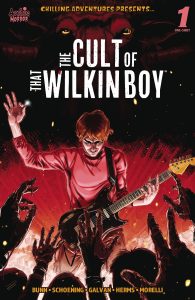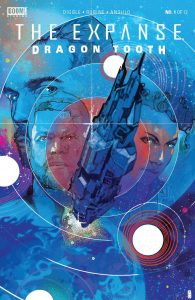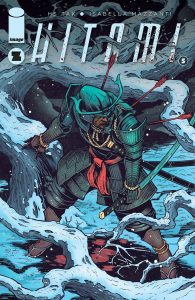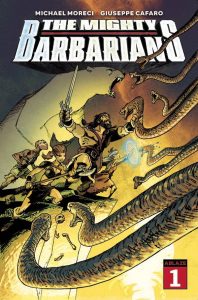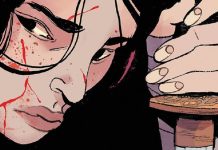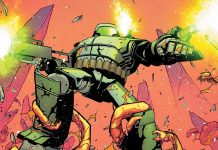This week’s lead review for Wednesday Comics is TerrorWar #1, a work-focused vision of a dystopian future. Plus, the Wednesday Comics Team has its usual rundown of the new #1s, finales and other notable issues from non-Big 2 publishers, all of which you can find below … enjoy!
 TerrorWar #1
TerrorWar #1
Story: Saladin Ahmed
Art: Dave Acosta
Inks: Jay Leisten
Colors: Walter Pereyra
Letters: Shawn Lee
Publisher: Image Comics
EXTREME!
Of all the sci-fi action in all the high concept indie comics in all the world, TerrorWar brings no heat and causes no sizzle, so creators Saladin Ahmed and Dave Acosta’s opening foray into a ’90s EXTREME Image Comics revival begins in a hushed, garbled tone.
Muhammad Cho is a poor dude living in a diverse, impoverished hood that deals with literal walking Terrors, pervasive dream ads, and my new nightmare, arm-tearing robot dogs called Credit Hounds! Muhammad works a minimum wage job as a Terrorfighter that oversells how glamorous or profitable it actually is regardless of the state-mandated propaganda permeating his waking life. We end ish #1 on a Big Two style arrival cliffhanger that lines up a conflict, but doesn’t give overall insight to the scope of this title.
Clocking in at 28 pages, TerrorWar is a surprisingly lightning quick read, mostly due to Acosta’s decision to draft around 16 of those 28 pages as splash pages (or rather, pages dominated by a single massive panel). I could perceive a want to drum up bombast through size and scale, but the action purely lacks give and take– problems arise and are summarily executed with a gun at no expense to the characters or reader. Whether that’s a flaw in Acosta’s character acting or Ahmed’s script, who can say, but let’s hope their collaboration refurbishes in subsequent outings; there are quite a few timing errors between dialogue and shot selection, so reading feels disjointed and not immersive. Ex: there’s an explosive pageturn that would be more shocking if in the preceding panel the object wasn’t torn to shreds before it explodes.
Really a shame the compositions are overwrought with Jay Leisten’s hatch-crazy inks– Acosta builds most of the back story in the background detail, but Leisten crowds the page with an unbalanced amount of cross-hatching that lacks purpose and rearranges focal points that the colors don’t recover from. For a sci-fi horror book, colorist Walter Pereyra was given a task too tall to surmount, and instead settles on muddy gradients, blur tooled-texture patches, and enough glows to only look great in backlight or on glossy paper. Beyond separation issues between foreground and background becoming apparent, the palette injects no mood; it is as stoic as Muhammad, but not better for it.
Aside from a tongue-in-cheek joke aimed at a corporate overlord we all adore, TerrorWar feels like styles clashing rather than cohering. Nowhere could that be more felt than in letterer Shawn Lee’s very DC Comics approach to captions and sfx. With seemingly pointless purple circuitry fluffing caption boxes and noncommittal sfx that feel dropped rather than placed, TerrorWar’s tone flows erringly into itself page after page.
If you can find it in your hearts to shell out for an EXTREME Ghostbusters strikeforce comic straight out of ’94 that doesn’t mesh well, then check a look.
Verdict: SKIP
Wednesday Comics Reviews
All Eight Eyes #1 (Dark Horse Comics): The premise of this new horror series is essentially “Spiders are creepy and it can be terrifying to just get by in New York these days.” And it’s an excellent one. All Eight Eyes #1 knows it has a good premise, too, and the creative team does a good job of not belaboring it. We open with our protagonist being ousted from his apartment for not paying his half of the rent. Point made, cleanly and effectively in one page. And then within three pages we get our first glimpse at the giant spiders that make for the other half of this horror story. That’s just a sample of how well this comic works — there’s a lot more to it than that. Overall, this is one of the best horror debut issues I’ve read this year. The creative team is writer Steve Foxe, artist Piotr Kowalski, colorist Brad Simpson, and letterer Hassan Otsmane-Elhaou. —Zack Quaintance
Billionaire Island: Cult of Dogs #6 (AHOY Comics): Eleven issues have all been leading to this — a delightfully off-the-rails finale that ties up (as much as is possible) a story about a dying world where billionaires isolate themselves on an island. At least, that’s what the story was about at the start. At the start of this finale, the richest being in the world is a dog, a cult has developed around said dog (Business Dog, with the Cult of Business Dog), and a man is dressing up as that dog to manipulate a powerful billionaire who may have a touch of dementia into not doing things on a whim that destroy what’s left of the planet. This is, in other words, a very good comic. One that you should make it a point to read in trade if you haven’t been aboard thus far. It’s written by Mark Russell, with art by Steve Pugh, color by Chris Chuckry, and letters by Rob Steen. —Zack Quaintance
Chilling Adventures Presents Cult of That Wilkin Boy #1 (Archie Comics): This Archie Horror one-shot puts Bingo Wilkin in the spotlight. Written by Cullen Bunn, with pencils by Dan Schoening, inks by Ben Galvan, colors by Matt Herms, and letters by the always-dependable Jack Morelli, The Cult of That Wilkin Boy presents a Faustian deal that doesn’t unfold by the numbers. This story is built on a twist, but it’s one that both makes sense given what’s set up by the story, and also distinct from the expected outcome for these crossroads deals. I particularly enjoyed the depiction of the literal demons that haunt Bingo. However, I am still curious how Bingo’s strangely intelligent dog, Rebel, who doesn’t appear in this story, might fit into this version of that Wilkin Boy’s life. Taken as a whole, these Archie Horror one-shots feel like a big horror comics anthology, doled out one story at a time… and as an alternative to an ongoing series, I’ve been enjoying that quite a lot. On a tangentially-related note, someone out there must have been consistently grabbing these incredible Robert Hack variant covers, which no doubt make quite an impressive collection. — Avery Kaplan
Doctor Atomic: The Pipe and Dope Book #1 (Image Comics): Created, written and illustrated by Larry Todd, this one-shot is a reprint from an older, underground comix stalwart. Right of the bat, you can tell this thing is underground comics from its linework, which invokes Robert Crumb in both style and irreverent humor. Doctor Atomic is a long bearded iconoclast who loves to challenge the status quo. Structured as like a manual, the book unfolds as Doctor Atomic explains to his neighbor, Billy, the ins and outs of smoking weed, different names for weed, ways to smoke it, it’s history in society and many other aspects of the plant. In a day and age where pot has become legal in most states, a book like this might not seem subversive, but in the context of it’s time, it’s a perfect example of how comics were such a vital part of the counter-culture and why so many were sold in headshops and smokeshops. It’s also beautifully illustrated, and reminds us that those underground comix of yore where much more than just humor books. —Manny Gomez
The Expanse: Dragon Tooth #1 (BOOM! Studios): Taking place between the ending of the season six finale of The Expanse and the seventh book (Persepolis Rising), writer Andy Diggle and artist Rubine work under the creative guidance of The Expanse creator James S.A. Corey to tie threads of the series together in this twelve-issue series. This first issue sets up political intrigue and unsteady alliances as characters reconcile with the past and the resources that everyone across class and political lines are seeking. Diggle works with a deft pen to set up the coming conflicts while providing lingering moments with the characters as they sit with the fallout of previous conflicts. Rubine’s art excellently captures the actors’ likenesses, the space and setup of the environments from the ships to space itself, and feels in line with the show, thanks in no small part to the colors of Raul Angulo and the letters of Pat Brosseau who unify the art with the visual aesthetics of the show from the fonts to the cool color palettes within the Rocinante’s interiors. –Khalid Johnson
Hitomi #5 (Image Comics): Hitomi #5 marks the conclusion of perfectly-executed miniseries. I have found this series to be an engrossing and well-done story start to finish. It’s also been one of those wonderful comics that put a very talented new creator on my radar with the work of artist Isabella Mazzanti. This is just a gorgeous and kinetic comic. It’s also well-written, with a story that feels like almost a deconstruction (in some ways) of the old Lone Wolf and Cub trope of an older samurai travelling with a younger protege. That broad framing is where the similarities stop, though. I also really enjoyed the way the team ended this comic. I certainly wouldn’t call it a happy ending, although there is some character progress made. More importantly, it leaves the door open for more interesting stories with the great characters we’ve just followed for five issues. —Zack Quaintance
The Mighty Barbarians #1 (Ablaze): Written by Michael Moreci with art by Giuseppe Cafaro, colors by Barbara Nosenzo, and letters by Jim Campbell, The Mighty Barbarians transports readers to the Hyborian Age for a thrilling fantasy adventure. This issue finds its protagonists facing an unstoppable force consuming one world after another. To stop it, sorceress Morgan Le Fay uses magic to assemble a team of warriors ranging from shape-shifters to Viking shield maidens. Each character feels well-developed, and the banter among everyone is engaging. The art here is exceptional. This series leans hard into the magic and violence of its fantasy setting, and the pages reflect that with dynamic layouts, brutal action, and vivid colors. Pages are bursting with action, shrouded in intrigue, or layered with emotion. Fantasy is littered with tropes, but this book executes them well. The premise here is compelling, and the entire creative team delivers exceptional work to make this an easy purchase. –Alex Batts
Read more entries in the Wednesday Comics reviews series!
Wednesday Comics is edited by Zack Quaintance.


